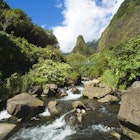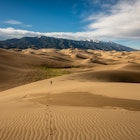
Jul 20, 2024 • 8 min read

Jul 7, 2020 • 3 min read

A record amount of waste has been removed © Jackson McMuldren / Ocean Voyages Institute
After a mammoth 48-day expedition, a crew from Ocean Voyages Institute has successfully removed a record amount of fishing nets and toxic consumer plastic from the Great Pacific Garbage Patch; the stretch of water located halfway between Hawaii and California considered to have the most plastic pollution in the world's oceans.
The clean-up mission began on 4 May at the Hawaiian port of Hilo, following a three-week quarantine period for all crew members, and ended in Honolulu 48 days later. Sailing on Ocean Voyages Institute's marine plastic recovery vessel, the crew successfully removed 103 tons (206,000 lbs) of fishing nets and plastic from the area known as the Great Pacific Garbage Patch, completing the "largest open ocean clean-up in history."

"I am so proud of our hard working crew,” said Mary Crowley, founder and executive director of Ocean Voyages Institute. "We exceeded our goal of capturing 100 tons of toxic consumer plastics and derelict ‘ghost’ nets, and in these challenging times, we are continuing to help restore the health of our ocean, which influences our own health and the health of the planet."

Ocean Voyages Institute is a small non-profit organisation based in San Francisco dedicated to ocean clean-ups. During this year's mission, the multinational crew tracked and collected rubbish using GPS satellite trackers, drones and good old-fashioned mast lookouts. Once the plastic and fishing nets were recovered from the water, they were placed in industrial bags and held until they could be recycled and repurposed back on land. Much of the damage caused to the marine ecosystem from plastic pollution was clearly visible, with the crew discovering a number of turtle skeletons tangled in discarded nets.
Sea turtles around the world are thriving without humans on the beaches

Purging the ocean of plastic pollution is not as simple as it sounds. "There is no cure-all solution to ocean clean-up: It is the long days at sea, with dedicated crew scanning the horizon, grappling nets, and retrieving huge amounts of trash, that makes it happen," said Locky MacLean, an ocean campaigner and crew member.
The Great Pacific Garbage Patch is one of the most remote regions of the Pacific Ocean and is essentially a giant soup of plastic debris. Some say it's about twice the size of Texas, three times the size of France or, in other terms, 600,000 square miles. This part of the ocean is a product of swirling currents that collect and concentrate debris, as well as plankton and other sea life. It's believed to contain around 80,000 tonnes of plastic trash, most of which comes from commercial fishing boats.

This year's mission nearly doubled last year's 25-day expedition. And next year, the Ocean Voyages Institute team hope to ramp up their efforts even further with three vessels operating in the Patch. Crowley is even hopeful that they can expand to other parts of the world, saying "there is no doubt in my mind that our work is making the oceans healthier for the planet and safer for marine wildlife, as these nets will never again entangle or harm a whale, dolphin, turtle or reefs."
How to reduce your use of plastic on a trip
The world's plastic wastelands documented by conservation photographer


Jul 20, 2024 • 8 min read

May 16, 2024 • 12 min read



Feb 21, 2024 • 2 min read


Jul 22, 2022 • 10 min read

Apr 9, 2022 • 5 min read

Mar 4, 2022 • 24 min read